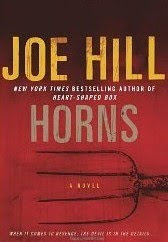Edgar Lee Masters's Spoon River Anthology is approaching the centennial mark of its first publication (in 1915), but the book still stands as the premier collection of American Gothic verse. These poetic gems--epitaphs voiced by the deceased inhabitants of Spoon River's cemetery--shine both individually
As you might guess from its title, my own Angry Villager Anthology, a poetry sequence that will begin tomorrow and run each day in October here at Macabre Republic (alongside other, Halloween-related posts), is modelled after Masters's masterpiece. The "anthology" gathers the dramatic monologues of the people of Grantwood, who have finally (on the next-to-last night of October) captured the monster that has been bedeviling their small town all month long. Now the blood-lusting mob of villagers plans to parade the creature through the streets of Grantwood, and then end the procession with a public execution in the town square. En route to their destination, the villagers fill in the backstory of the monster's misdeeds but at the same time expose the dark heart of their own community.
In preparation for tomorrow's start of the Angry Villager Anthology, I thought I would post some samples from the Spoon River Anthology (which is in the public domain) today. The book's framing poem "The Hill" appears below, followed by selections of individual monologues.
The Hill
Where are Elmer, Herman, Bert, Tom, and Charley,
The weak of will, the strong of arm, the clown, the
boozer, the fighter?
All, all, are sleeping on the hill.
One passed in a fever,
One was burned in a mine,
One was killed in a brawl,
One died in a jail,
One fell from a bridge toiling for children and wife--
All, all are sleeping, sleeping, sleeping on the hill.
Where are Ella, Kate, Mag, Lizzie, and Edith,
The tender heart, the simple soul, the loud, the proud
the happy one?--
All, all are sleeping on the hill.
One died in a shameful child-birth,
One of a thwarted love,
One at the hands of a brute in a brothel,
One of a broken pride, in the search for heart's desire,
One after life in far-away London and Paris
Was brought to her little space by Ella and Kate and
Mag--
All, all are sleeping, sleeping, sleeping on the hill.
Where are Uncle Isaac and Aunt Emily,
And old Towny Kincaid and Sevigne Houghton
And Major Walker who had talked
With venerable men of the revolution?--
All, all are sleeping on the hill.
They brought them dead sons from the war,
And daughters whom life had crushed,
And their children fatherless, crying--
All, all are sleeping, sleeping, sleeping on the hill.
Where is Old Fiddler Jones
Who played with life all his ninety years,
Braving the sleet with bared breast,
Drinking, rioting, thinking of neither wife nor kin,
Nor gold, nor love, nor heaven?
Lo! he babbles of the fish-frys of long ago,
Of the horse races of long ago at Clary's Grove,
Of what Abe Lincoln said
One time at Springfield.
Amanda Barker
Henry got me with child,
Knowing that I could not bring forth life
Without losing my own.
In my youth therefore I entered the portals of dust.
Traveler, it is believed in the village where I lived
That Henry loved me with a husband's love,
But I proclaim from the dust
That he slew me to gratify his hatred.
Constance Hately
You praise my self-sacrifice, Spoon River,
In rearing Irene and Mary,
Orphans of my older sister!
And you censure Irene and Mary
For their contempt for me!
But praise not my self-sacrifice,
and censure not their contempt;
I reared them, I cared for them, true enough!--
But I poisoned my benefactions
With constant reminders of their dependence.
Chase Henry
In life I was the town drunkard;
When I died the priest denied me burial
In holy ground.
The which redounded to my good fortune.
For the Protestants bought this lot,
And buried my body here,
Close to the grave of the banker Nicholas,
And of his wife Priscilla.
Take note, ye prudent and pious souls,
Of the cross-currents in life
Which bring honor to the dead, who lived in shame.






















